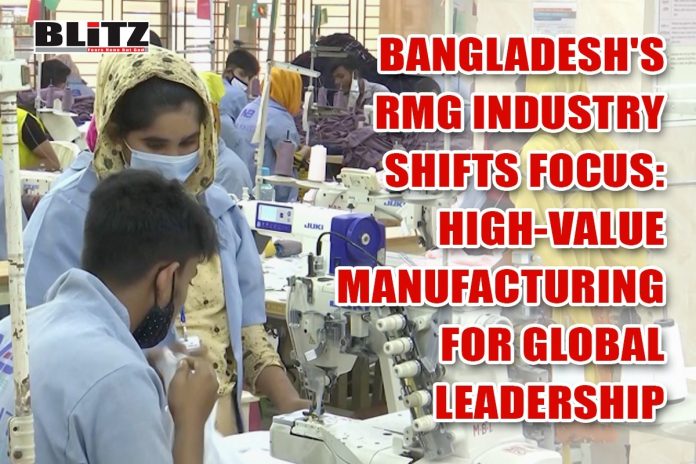Bangladesh’s economy heavily relies on the export of ready-made garments (RMG), constituting around 85% of the country’s total export earnings. Despite securing the second position globally in RMG exports, Bangladesh faces challenges such as lower product prices, limited product diversification, and an overreliance on cotton-made products. To propel the nation towards sustainable economic progress, it is imperative for Bangladesh to transition from manufacturing basic items to high-value apparel, incorporating innovation, technology, and skilled manpower.
Despite four decades of remarkable growth in the RMG industry, Bangladesh struggles to command higher prices for its products compared to competitors like China, India, Vietnam, and others. The overemphasis on cotton-made products, lack of product diversification, and a shortage of skilled manpower and modern technology are hindering the country’s ability to increase income from apparel exports.
Statistics reveal that Bangladesh’s share in the global RMG market is only 7.90%, significantly lower than China’s 31.7%. The unit price of exported apparel to the EU also reflects the challenge, with Bangladesh’s $17.14 per kg lagging behind India, China, Turkey, and Vietnam.
To overcome these challenges, Bangladesh must shift its focus from low-value basic items to high-value products. Currently, 32% of exported items are trousers, 23% T-shirts and knitwear, and 13% sweaters. The country needs to strategically diversify its product range, emphasizing active wear, outwear, denim, lingerie, suits, fancy dresses, and formal wear.
Moreover, Bangladesh’s manufacturers face resistance from international buyers when attempting to increase product prices. The call for ethical and fair prices is justified, especially considering the rising costs of apparel production. Bangladesh should actively promote its commitment to ethical working conditions and fair wages, addressing concerns raised by foreign buyers.
The garment industry’s success hinges on innovation, technological upgradation, design, skill development, and overall business capabilities. Despite a 45-year history, the industry still lacks adequate modern machinery and skilled manpower. Bangladesh’s reliance on foreign workers underscores the need for intensified efforts in training textile engineers and fashion designers domestically.
The establishment of the BGMEA University of Fashion & Technology (BUFT) is a positive step, with around 20,000 graduates having completed their education. The university’s curriculum updates and increased yearly graduates aim to reduce dependence on foreign workers. However, further investment in skill development and training is essential to meet the industry’s growing demands.
Bangladesh has made strides in adopting environmentally friendly practices, with 206 LEED-certified green factories, 19 of which rank among the top globally. This commitment positions Bangladesh’s RMG industry for a sustainable future. The emphasis should now be on leveraging this green momentum to enhance efficiency, develop new products, and embrace innovative technologies.
Strategic Recommendations for Bangladesh’s RMG Industry:
- Product Diversification:
Bangladesh should aggressively diversify its product range, moving beyond basic items to focus on high-value segments such as active wear, outwear, denim, lingerie, suits, fancy dresses, and formal wear.
- Ethical Pricing and Market Expansion:
The industry should engage with international buyers to communicate its commitment to ethical practices and fair wages. Simultaneously, an aggressive market expansion policy will help capture new markets and increase bargaining power.
- Skill Development:
Continued investment in domestic skill development, especially for textile engineers and fashion designers, is essential. BUFT and similar institutions should collaborate with industry stakeholders to ensure the curriculum aligns with industry needs.
- Technology Adoption:
Bangladesh must invest in modern machinery and technology to enhance efficiency and stay competitive in the global market. The industry should actively seek partnerships with technology providers and research institutions for innovation.
- Green Initiatives:
The focus on environmentally friendly practices should continue, with an emphasis on integrating sustainability into every aspect of the supply chain. This includes exploring eco-friendly materials and production processes.
- Efficiency Enhancement:
The industry needs to streamline operations for efficiency gains. This involves optimizing production processes, reducing waste, and implementing lean manufacturing principles.
- Market Research and Innovation:
Continuous market research is crucial for identifying emerging trends and consumer preferences. Bangladesh’s RMG industry should prioritize innovation in design, materials, and production techniques to stay ahead of the curve.
Bangladesh stands at a critical juncture in its RMG industry’s evolution. The challenges faced, including low product prices, limited diversification, and skill shortages, require a strategic shift towards high-value manufacturing. By embracing innovation, technology, ethical practices, and sustainability, Bangladesh can position itself as a leader in the global apparel market, ensuring long-term economic progress and stability. The industry’s stakeholders, including government bodies, educational institutions, and private enterprises, must collaborate to drive this transformative agenda and secure a prosperous future for Bangladesh’s apparel sector.





Timely decision.